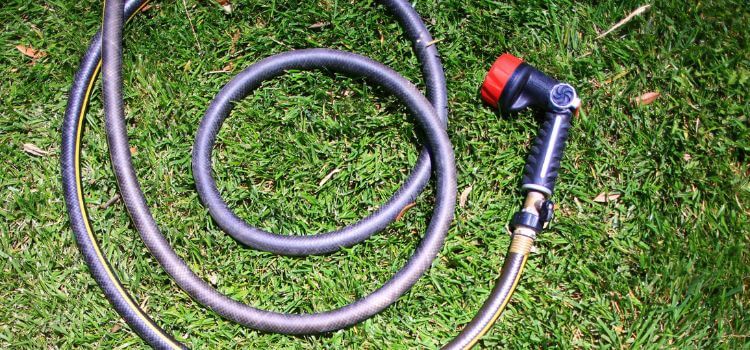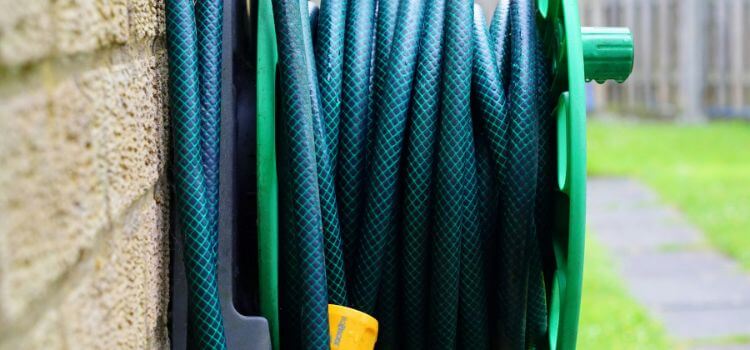As an Amazon Associate, I earn from qualifying purchases.
Garden hoses are one of those garden tools we often take for granted. They are the unseen heroes in gardening, providing life-sustaining water to our plants and lawns.
But what happens when the bearer of liquid life becomes the very thing that threatens plant health? Improperly maintained hoses can serve as hotbeds for mold, algae, and bacteria.
We must learn how to clean a garden hose for the sake of our plants and our well-being.This guide covers cleaning your hose, maintaining your garden, and maintaining your watering equipment.

Why Clean Your Garden Hose?
A garden hose is a happy home for all kinds of microorganisms. Stagnant water, high temperatures, and organic buildup favour algae, mould, and bacteria. Clogging your hose reduces water flow and contaminates the water you use to water your lawn.
Think about all the fragile seedlings, the vibrant flowers, and the succulent produce you pour this water onto. You’re not just giving them water; you may be giving them a cocktail of diseases that could stunt their growth or even kill them. Why garden hose cleaning is necessary, more detail below.
Better Plant Health
Clean water is directly related to the well-being of your plants. Microorganisms in dirty water can produce diseases that harm your garden—using a clean hose safeguards against these risks. These ensure plant health and longevity.
How to Clean a Garden Hose?
There are several approaches to cleaning a garden hose, each with benefits. You may prefer one method, but all are effective when done correctly.
Manual Cleaning with Brushes
Use a long-handled bottle brush to scrape the inside of your garden hose. This method is low-cost and requires no chemicals, but it can be time-consuming, especially for longer hoses.
Steps:
- Remove the hose from the water source and drain any residual water.
- Use the brush to scrub the interior walls of the hose.
- Rinse the hose thoroughly to remove loosened debris.
Using Vinegar and Baking Soda
Natural and safe materials like vinegar and baking soda can also effectively clean your garden hose. They are Dealing with mineral buildup and organic contaminants.
Steps:
- Combine white vinegar and water at a ratio of 1:1.
- Pour this mixture into the hose, ensuring it coats the insides.
- Be sure to include a couple of tablespoons of baking soda.
- Quickly cap or plug the ends of the hose to keep the fizzing action inside.
- After a few hours or overnight, rinse the hose thoroughly.
Commercial Hose Cleaning Products
Commercial products are designed specifically for cleaning garden hoses for a deeper clean without any guesswork. They effectively remove all kinds of buildup and contaminants.
Steps:
- Follow the manufacturer’s instructions, as they can vary from product to product.
- Usually, this involves filling the hose with the cleaning solution, letting it sit, and then thoroughly rinsing it.
Regardless of your preferred method, you must read manufacturer instructions on cleaning products. Some hoses may be sensitive to certain chemicals.
Clean Water Quality
Beyond plant health, using a clean hose means better water quality. For gardens that grow vegetables or fruits, waterborne contaminants can affect the safety of the produce. A clean hose delivers clean water essential for organic and sustainable gardening practices.
When to Clean Your Garden Hose
The first step is to recognize the need for cleaning, and doing it at the right time is crucial. The timing of your garden hose cleaning largely depends on how frequently you use it. However, a thorough cleaning is essential for a few critical times.
End of Gardening Season
At the end of the season, your hose has likely seen a lot of action. It’s time to prepare it for a clean and fresh start in the next planting season.
After Pesticide Use
If you’ve just sprayed pesticides through your hose, it’s crucial to rinse it out thoroughly to prevent any chemicals.

Post-Fertilization
Similar to pesticide use, after using incredibly robust fertilizers, you should clean your hose to remove harmful chemicals. That could be harmful if they make their way into your water supply.
Visible Contamination
Inspect your hose for signs of algae, mould, or other unsightly residues. These contaminants provide a clear signal that cleaning is overdue.
Odor in Water
If you notice unpleasant odours when the water starts flowing, there’s likely a buildup within your hose that needs to be addressed.
Change in Water Quality
Should your plants start to show opposing responses to their watering routines, take a look at your hose as a potential source of the problem.
Tips for Maintenance
Besides cleaning, hose maintenance can detect issues early and maximize your investment.
Regular Inspections
After every use, give your hose a quick once-over. Check for kinks, abrasions, and leaks. The sooner you catch these issues, the easier they are to fix, and the less likely they will lead to a burst hose.
Proper Storage Techniques
Storing your hose can prevent kinks, cracks, and other damage. A hose reel or a simple coil placed on a hook can keep your hose in good shape and make it easier to use next time you need it.

Troubleshooting Common Issues
A garden hose can present several issues that indicate the need for cleaning or maintenance. Knowing what to look for and how to handle these problems will make you a more effective housekeeper.
Mold and Mildew Removal
If you notice a musty odour or black spots on the interior walls of your hose, you see the results of mould and mildew. This can happen if there’s water left in the hose, especially in a warm or sunny location.
Steps for Removal:
- Wash the hose with a diluted bleach solution or a commercial mould and mildew cleaner.
- Ensure the hose is completely dry before reusing it.
Dealing with Kinks and Leaks
These issues are often the result of improper storage or handling and can sometimes be signs that a cleaning is necessary.
Kinks:
- To remove kinks, straighten the hose and allow it to relax.
- Coiling the hose in a larger loop instead of tight, small circles can prevent kinking.
Leaks:
- To fix leaks, you may need to cut out the damaged portion of the hose and attach a repair coupling.
- Regular inspections and cleaning can help you notice and prevent leaks.
FAQs on How to Clean a Garden Hose
We recommend cleaning your garden hose at least once at the beginning of the gardening season and again at the end before storing it. However, if you use your hose frequently or for drinking water (pet drinking or filling a pool), you should clean it more regularly.
You will need a bucket, mild dish soap or a vinegar solution (2 cups of vinegar to 1 gallon of water), a brush with a long handle, and bleach if you wish to disinfect further.
Use a sponger or cloth with soapy water to wipe down the hose’s exterior. For more stubborn dirt, use a soft-bristled brush. Rinse the hose with clean water afterwards.
After rinsing your hose, stretch it straight in a sunny area to ensure it dries entirely inside. Elevating one end can help any remaining water drain out more quickly. Dry the hose before storing it to avoid mould and mildew.
Regular, proper cleaning should not adversely affect the durability of your garden hose. It will help extend its life by preventing mould and mould growth and debris buildup that can lead to deterioration over time.
Conclusion
Maintaining a clean garden hose is as essential as keeping your plants, lawn, or any other garden tool. Using this guidance, clean and maintain your garden and hose to ensure satisfaction and efficiency every season. With a little effort, regular garden cleaning and upkeep may be quick and easy.
Remember, a clean garden hose means clean water, which leads to a healthier garden. Use this approach to start your gardening season with a lush lawn, vivid flowers, and ample fruit.

